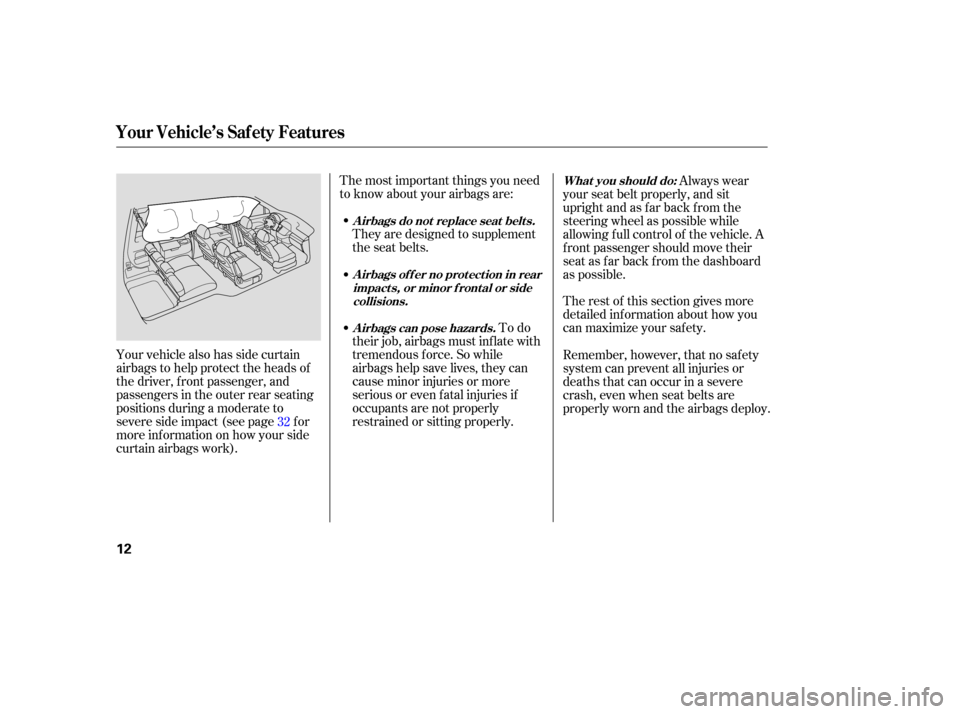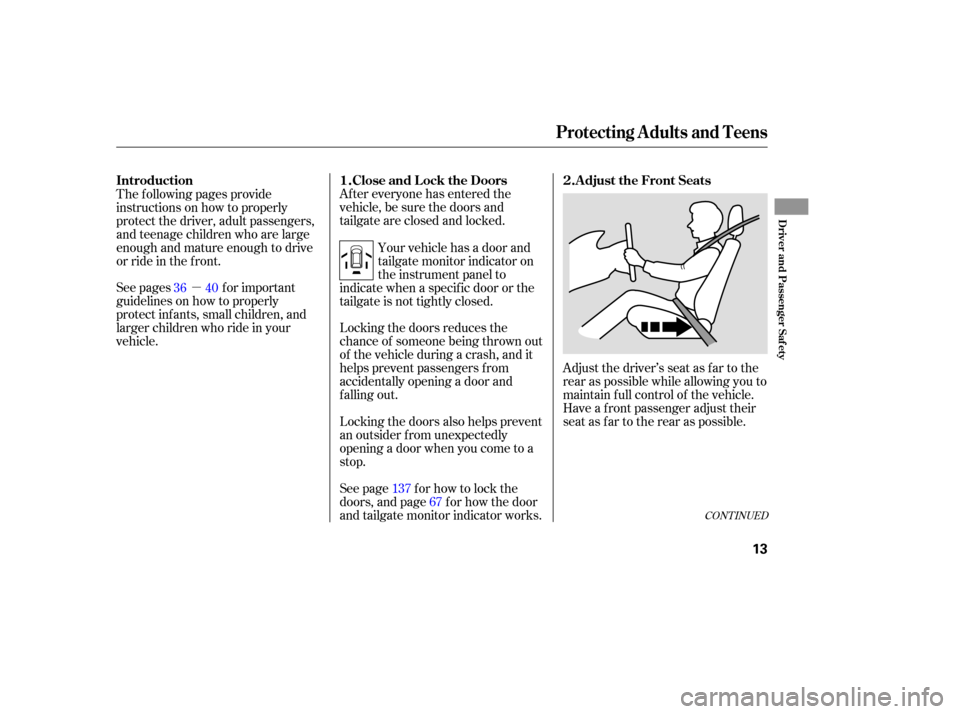Page 5 of 414
Your Vehicle at a Glance
4
AUDIO SYSTEM/
REAR ENTERTAINMENT
SYSTEM
PARKING BRAKE
PEDAL
FUEL FILL
DOOR RELEASE
HOOD RELEASE
HANDLE
POWER WINDOW
SWITCHES
POWER
DOOR LOCK
SWITCHES INSTRUMENT PANEL INDICATORS
GAUGES SHIFT LEVER
CLIMATE CONTROL SYSTEM
MIRROR
CONTROLS
ACCESSORY POWER
SOCKETS
(P.61,
62)
(P.71)
(P.137)
(P.182)(P.171)(P.180)
HEATING AND COOLING SYSTEM/
(P.188)
(P.279) (P.280) (P.199,
230)
(P.294)
CENTER TRAY
(P.168)
(P.163)
(P.169)SEAT HEATER
SWITCHES
(P.160)
Seat Memory
Switches
(P.161)
GLOVE BOXES
Page 10 of 414
Your vehicle is equipped with many
features that work together to
protect you and your passengers
during a crash.
Some f eatures do not require any
action on your part. These include a
strong steel f ramework that f orms a
saf ety cage around the passenger
compartment; front and rear crush
zones; a collapsible steering column;
and tensioners that tighten the f ront
seat belts in a crash.
CONT INUED
Your Vehicle’s Saf ety Features
Driver and Passenger Saf ety
9
(1)(2)
(2)
(3)
(4)
(5) (6)
(7) (8)
(8)
(7) (9)
(9)
(11)
(10)
(1) Safety Cage
(2) Crush Zones
(3) Seats and Seat-Backs
(4) Head Restraints
(5) Collapsible Steering Column
(6) Seat Belts
(7) Front Airbags
(8) Side Airbags
(9) Side Curtain Airbags
(10) Front Seat Belt Tensioners
(11) Door Locks
Page 11 of 414

Your vehicle is equipped with seat
belts in all seating positions.
Your seat belt system also includes
an indicator on the instrument panel
to remind you and your passengers
to f asten your seat belts.
Seat belts are the single most
effectivesafetydeviceforadultsand
larger children. (Inf ants and smaller
children must be properly restrained
in child seats.)
Not wearing a seat belt properly
increases the chance of serious
injury or death in a crash, even
though your vehicle has airbags.
In addition, most states and all
Canadian provinces require you to
wear seat belts.
However, you and your passengers
can’t take f ull advantage of these
f eatures unless you remain sitting in
a proper position and
. In f act, some saf ety
f eatures can contribute to injuries if
they are not used properly.
When properly worn, seat belts:Keep you connected to the vehicle
so you can take advantage of the
vehicle’s built-in saf ety f eatures.
Help protect you in almost every
type of crash, including f rontal,
side, and rear impacts and
rollovers.
The f ollowing pages explain how you
cantakeanactiveroleinprotecting
yourself and your passengers.
Your Vehicle’s Saf ety Features
Seat Belts
Why Wear Seat Belt s
always wear
your seat belt s
10
Not wearing a seat belt properly
increases the chance of serious
injury or death in a crash, even
though your vehicle has airbags.
Be sure you and your
passengers always wear seat
belts and wear them properly.
Page 13 of 414

The rest of this section gives more
detailed inf ormation about how you
can maximize your saf ety.
The most important things you need
to know about your airbags are:
They are designed to supplement
the seat belts.
To do
their job, airbags must inf late with
tremendous f orce. So while
airbags help save lives, they can
cause minor injuries or more
serious or even fatal injuries if
occupants are not properly
restrained or sitting properly. Always wear
your seat belt properly, and sit
upright and as f ar back f rom the
steering wheel as possible while
allowing f ull control of the vehicle. A
f ront passenger should move their
seat as far back from the dashboard
as possible.
Your vehicle also has side curtain
airbags to help protect the heads of
the driver, f ront passenger, and
passengers in the outer rear seating
positions during a moderate to
severe side impact (see page f or
more inf ormation on how your side
curtain airbags work). Remember, however, that no saf ety
system can prevent all injuries or
deaths that can occur in a severe
crash, even when seat belts are
properly worn and the airbags deploy.
32
Your Vehicle’s Saf ety Features
Airbags do not replace seat belts.
A irbags of f er no prot ect ion in rearimpact s, or minor f ront al or sidecollisions.
A irbags can pose hazards. What you should do:
12
Page 14 of 414

�µAf ter everyone has entered the
vehicle, be sure the doors and
tailgate are closed and locked.
Locking the doors reduces the
chance of someone being thrown out
of the vehicle during a crash, and it
helps prevent passengers f rom
accidentally opening a door and
f alling out.
Locking the doors also helps prevent
an outsider f rom unexpectedly
opening a door when you come to a
stop. Adjust the driver’s seat as far to the
rear as possible while allowing you to
maintain f ull control of the vehicle.
Have a front passenger adjust their
seat as far to the rear as possible.
The f ollowing pages provide
instructions on how to properly
protect the driver, adult passengers,
and teenage children who are large
enough and mature enough to drive
or ride in the f ront.
See pages f or important
guidelines on how to properly
protect inf ants, small children, and
larger children who ride in your
vehicle.
See page f or how to lock the
doors, and page f or how the door
and tailgate monitor indicator works.Your vehicle has a door and
tailgate monitor indicator on
the instrument panel to
indicate when a specif ic door or the
tailgate is not tightly closed.
36 40
67
137
CONT INUED
Introduction
Close and L ock the DoorsA djust the Front Seats
1. 2.
Protecting A dults and Teens
Driver and Passenger Saf ety
13
Page 31 of 414

When the airbag is turned of f , an
indicator in the center of the
dashboard will come on indicating
passenger airbag ‘‘OFF’’ (see page).
If there is no passenger in the f ront
seat, the airbag will be off. However,
the Passenger Airbag Of f indicator
will not come on.
To ensure that the passenger’s
advanced front airbag system will
work properly,
This includes: A rear passenger pushing or
pulling on the back of the
passenger’s seat. Moving the f ront seat f orcibly
back against cargo on the seat or
f loor behind it.
Hanging heavy items on the f ront
passenger seat, or placing heavy
items in the seat-back pocket.
If you ever have a moderate to
severe side impact, sensors will
detect rapid acceleration and signal
the control unit to instantly inf late
either the driver’s or the passenger’s
side airbag and activate the seat belt
tensioner.
33
Additional Inf ormation About Your Airbags
How Your Side A irbags Work
do not do anyt hing
t hat would increase or decrease t he weight on t he f ront passenger’s seat .
30
Page 35 of 414

Even if your
airbags do not inflate, your dealer
should inspect the driver’s seat
position sensor and the f ront
passenger’s weight sensors to
make sure they are operating
properly.
Any airbag
that has deployed must be
replaced along with the control
unit and other related parts. If a
f ront airbag inf lates, the seat belt
tensioners must also be replaced.
Do not try to remove or replace
anyairbagbyyourself.Thismust
be done by your dealer or a
knowledgeable body shop.
Take your vehicle to an
authorized dealer as soon as
possible. If you ignore this
indication, your airbags may not
operate properly.
Your airbag systems are virtually
maintenance f ree, and there are no
parts you can saf ely service.
However, you must have your
vehicle serviced if:
If no one is riding in the f ront seat,
the airbag will be automatically shut
of f . However, the indicator will not
come on.
If the indicator comes on with no
passenger in the f ront, or with an
adult in the seat, there may be a
problem with the advanced airbag
system. Have the vehicle checked by
the dealer as soon as possible.
The Passenger Airbag Of f indicator
may also come on and of f repeatedly
if total weight on the seat is near the
airbag cutof f threshold.
If this happens, have the passenger
ride properly restrained in a back
seat. If the passenger must ride in
front, move the seat as far to the
rear as possible, and have the
passenger sit upright and wear the
seat belt properly.
Additional Inf ormation About Your Airbags
If your vehicle has a moderat e t o
severe impact .
An airbag ever inf lates.
T he SRS indicat or alert s you t o aproblem.Airbag Service
34
Page 38 of 414

�µ
Front airbags have been designed to
help protect adults in a moderate to
severe f rontal collision. To do this
the passenger’s f ront airbag is quite
large, and it can inflate with enough
f orce to cause very serious injuries.
According to accident statistics,
children of all ages and sizes are
saf er when they are restrained in a
back seat. The National Highway
Traf f ic Saf ety Administration and
Transport Canada recommend that
all children age 12 and under be
properly restrained in a back seat.
Children who ride in back are less
likely to be injured by striking
interior vehicle parts during a
collision or hard braking. Also,
children cannot be injured by an
inflating front airbag when they ride
in the back. Even though your vehicle has an
advanced front airbag system, which
can automatically turn the
passenger’s f ront airbag of f (see
page ), please f ollow the
guidelines below.
If
the airbag inf lates, it can hit the back
of the child seat with enough force
to kill or very seriously injure an
inf ant. If the vehicle seat is
too far forward, or the child’s head is
thrown f orward during a collision, an
inflating front airbag can strike the
child with enough f orce to kill or
very seriously injure a small child.
Whenever possible,
larger children should sit in the back
seat, on a booster seat if needed, and
be properly restrained with a seat
belt. (See page f or important
inf ormation about protecting larger
children.) 51
29
The Passenger’s Front Airbag
Can Pose Serious Risks
All Children Should Sit in a Back
Seat
Inf ant s
Never put a rear-f acing child seat int he f ront seat of a vehicle equippedwit h a passenger’s f ront airbag. Small Children
Placing a f orward-f acing child seat int he f ront seat of a vehicle equippedwit h a passenger’s f ront airbag canbe hazardous.
Larger ChildrenChildren who have outgrown childseat s are also at risk of being injuredor killed by an inf lat ing passenger’sfront airbag.
Protecting Children General Guidelines
Driver and Passenger Saf ety
37